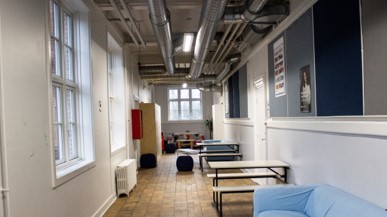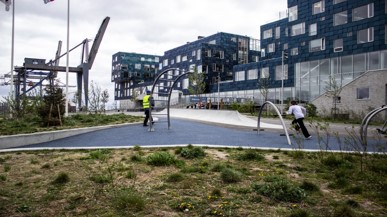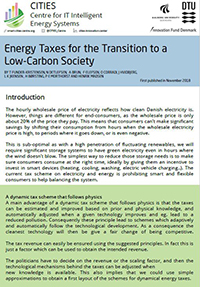Policy & regulations
Taxes and tariffs must support the green transition: The development of new energy policies and efficiency regulation schemes is becoming more and more important for successfully integrated the increasing amount of variable energy resources and saving CO2. CITIES task force group (Danfoss, Teknologisk Institut, Grundfos, Ørsted, Grøn Energi, Tomorrow, Aalborg Universitet & DTU) has worked with the barriers in the regulatory framework like tax legislation and regulation of infrastructures.
The main recommendations are:
- Taxes and tariffs must support flexibility
- The tax should incentives the use of green energy
- The tariff must depend on the load in the network
- Geographical and thematic test zones to ensure the pricing system works
We are looking into a future with increased electrification that places great demands on our electricity grid. We, therefore, need to provide incentives for both consumption and production, which support the flexibility more than today and that enables us to develop and operate a green energy system for as little money as possible.
Variable taxes and tariffs should support flexibility
Taxes have typically been a balance between a tax revenue for the state and payment for an externality such as environmental impact and pollution. Tariffs are payment for transport in infrastructure, and electricity tariffs are under discussion in these years. Both are means to an end; they can be defined and arranged in different ways, but there are freedoms as to what they should support.
We need to support a smart, green energy system that is based to a much greater extent than before on decentralized production and is integrated to a much greater extent across technologies. Therefore, both variable taxes and tariffs should provide incentives for both consumption, production and innovation, which better support the flexibility that enables us to operate a green energy system for as little money as possible. This applies to investments in infrastructure, capacity, energy and digitization. We do this, among other things, by fees and tariffs that follow the physics more closely.
The tax should incentives the use of green energy
For taxes, this means that a large part of the tax must follow the externalities, and the most important thing in this context is CO2. In addition, taxes are the right incentive to save energy. Another important point is that increased tax revenue must be returned to companies in a way that accelerates innovation in and implementation of flexible and energy-efficient low-emission technologies.
In this way, we can support the green transition in Denmark and create the next generation of sustainable winning companies that can scale their solutions globally.
The tariff must depend on the load in the grid
For tariff design CITIES task force recommend that tariffs follow the physics in the grid. Therefore, the tariff must depend on the load in the network.
The ultimate right solution, in the end, is to make dynamic tariffs determined by the load now and here. Until we are ready for that, it is important to focus on tariffs that support this green transition, and therefore reward players who are flexible and therefore do not give rise to increased investment. Examples of flexible consumption are both electric cars that can control charging, and especially large electric boilers and heat pumps in district heating systems. But there is a big difference in the duration of flexibility. CITIES task force recommend that the flexibility also should be reflected in the pricing of a tariff system.
Geographical and thematic test zones
To test and ensure the setup of the pricing system CITIES task force recommend using larger and smaller geographical test zones with different technological set-ups and price models with flexible tariffs and taxes and in relation to cities and buildings that are characteristic of Danish society.
See the recommendations and videos below.
Suggestions for new energy taxes and net tariffs
At CITIES final conference November 9, 2020, CITIEs Task Force group represented by Nina Detlefsen, Chief Analyst at Green Energy – Danish District Heating Association and Jan Hvidbjerg, Lead Analyst at Ørsted talked about the work with energy taxes and net tariffs. A well-designed price signal for end users will make them change their behavior, just as energy taxes should be linked to the current local load in the electricity grid.
The Low-carbon transition: Challenges, status and possibilities
From CITIES – Centre for IT-Intelligent Energy Systems – final conference November 9, 2020: KEYNOTE from Olivier Corradi, CEO at Tomorrow: If we don’t do anything about the CO2-emission, we have nowadays, we will need a Corona lockdown period all over the world as we saw in spring 2020 to keep the temperature rise at 2 degrees as in the Paris Agreement. So we need new ways of doing things – hereunder computing the demand and production in relation to when the energy comes from renewable sources, Olivier says.
Market-Based Mechanisms for Mobilizing Electric Demand Flexibility
At CITIES final conference Shmuel Oren, Professor, University of Berkeley, California, US talked about market-based mechanisms for mobilizing electric demand flexibilityand with slides from Niclas Brok, PhD student, DTU Compute.
Achievements and recommendations
Findings in CITIES – now we wait for the politicians: Possible benefits from digitalization: Up to 800 mill dkr annually in Denmark by data-driven temperature optimization (tons of CO2 savings), 10-30 pct savings by predictive control of heat pumps, 5-15 pct savings by integrating forecasts in smart house controllers, 10-40 pct improvements of electricity and heat load forecasts, up to 10 pct savings by optimal operations of CHP and DH plants, 5-12 pct savings by smart wastewater treatment, 10-20 pct savings on cooling for supermarkets, up to 90 pct savings on cooling for data centres. We could possibly be fossil-free tomorrow.
Recommendations
-
We need to use strategic energy planning to aim for emission goals
The objective of strategic energy planning is often linked to technical solutions like a certain share of biomass or a number of electric vehicles to reach. Instead the objective should be defined in terms of emission goals, since this allows more flexibility in finding solutions and strategies. Emission calculations have to be standardized. And in order to avoid carbon leakages we need to ensure that the emission calculations are on the same cobber plate (e.g. within the price-zone DK1). -
Emission calculations should be linked to the hour and standardized
We need to ensure that emissions are accounted for within the hour and the declaration has to be well defined in relation to Granulated Guarantees of Origin (GGOs), self production, etc. We must avoid carbon leakage between price areas (cobber plates). -
We must remove barriers for sector coupling and use of excess heat
We must ensure that the energy taxes are homogenous and hence that excess heat from some process can be used eg. in district heating without hitting any barriers. -
New dynamic tariff structures should be tested and established
New dynamic tariff structures should be developed, tested and established. We need tariffs that are linked to the physics of the system, i.e., the actual load compared to the capacity (kW-related) and to the transport loss (kWh-related). We have suggestions for the design of new tariffs and how the tariffs should be finally tested in test zones (see https://smart-cities-centre.org/material/ under “Task Force”). -
New CO2 related energy taxes need to be established now
We need homogenous CO2-related green taxes as soon as possible to reduce CO2 emissions. The challenges for the process industry that are connected to this can be converted to “help to self help” by paying into a fund that can finance green initiatives for the industry in collaboration with universities. -
Tests of regulatory conditions and solutions should be representative for and scalable to the entire Danish society
When new framework conditions and solutions are tested, they should be tested in environments that allow us to make conclusions for the entire Danish society. This could be for example, in defined test zones or living labs with a representative cross section of the Danish society and building stock. We have suggestions for setups for both thematic and geographical test zones (see https://smart-cities-centre.org/material/ under “Task Force”).
Solutions/methodologies
-
Tool for simulating occupancy profiles for private households
ProccS.org is a tool for simulating occupancy profiles for private households. The application creates occupancy profiles for bathroom, kitchen, living room and bedrooms. The profiles can be downloaded in csv-format. - There is a need for better coordination between energy systems locally, regionally and nationally in order to take advantage of sectoral coupling between energy systems
Demo projects

Energy Supply Modelling in cities: A Case Study of Sønderborg Municipality
The demonstration project has developed a model and evaluated scenarios for Sønderborg’s energy system in 2029 in order to identify ways of increasing the efficiency and integration of the system while minimizing CO2 emissions and socioeconomic costs.

Qualitative investigation of the impact of energy communities on distribution grids
The demo project has made a simple analysis of the impact of energy communities on three different grid layouts: urban, suburban and rural areas of Denmark to estimate consequences of different setups of energy communities on distribution grids.

